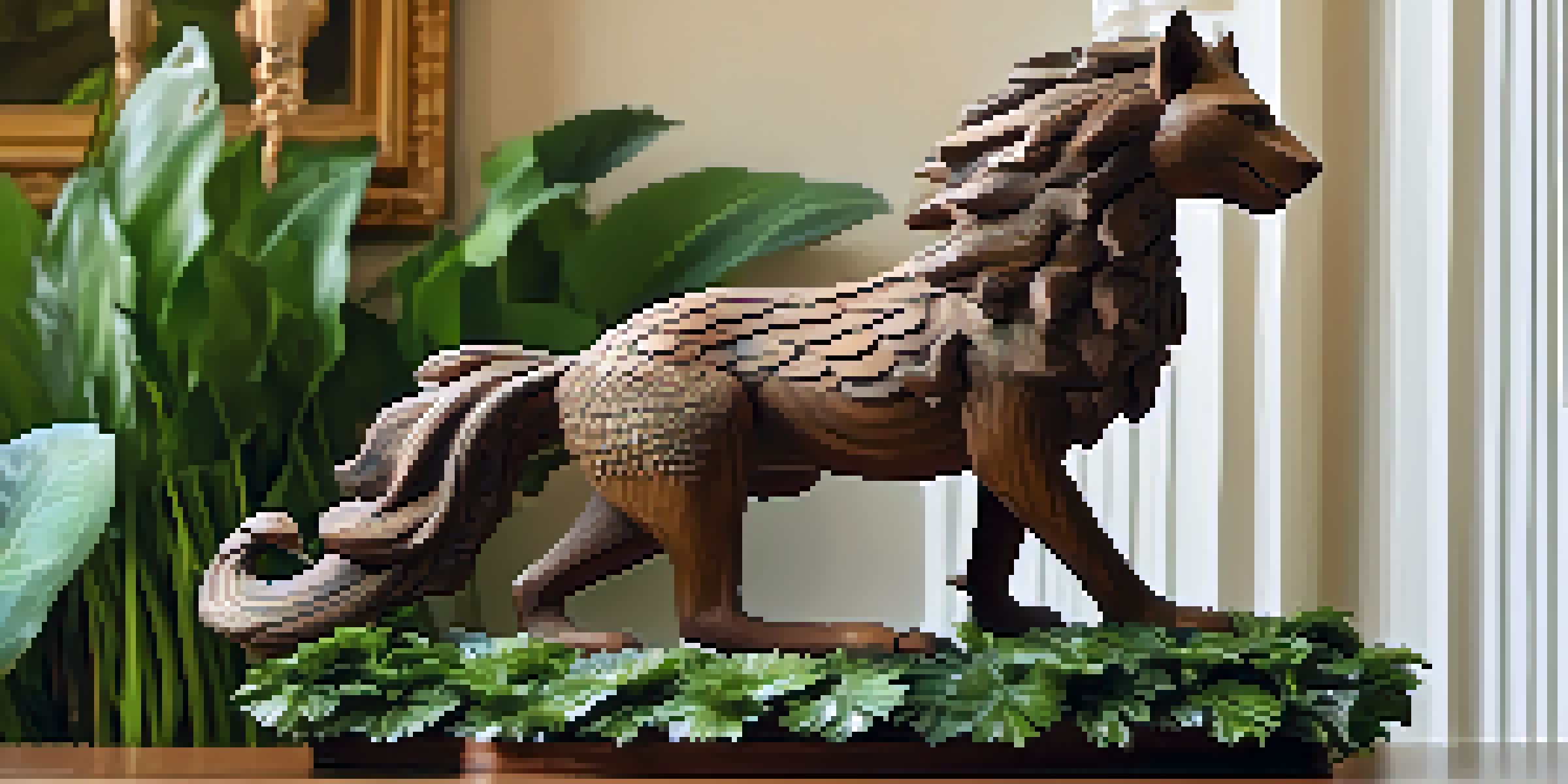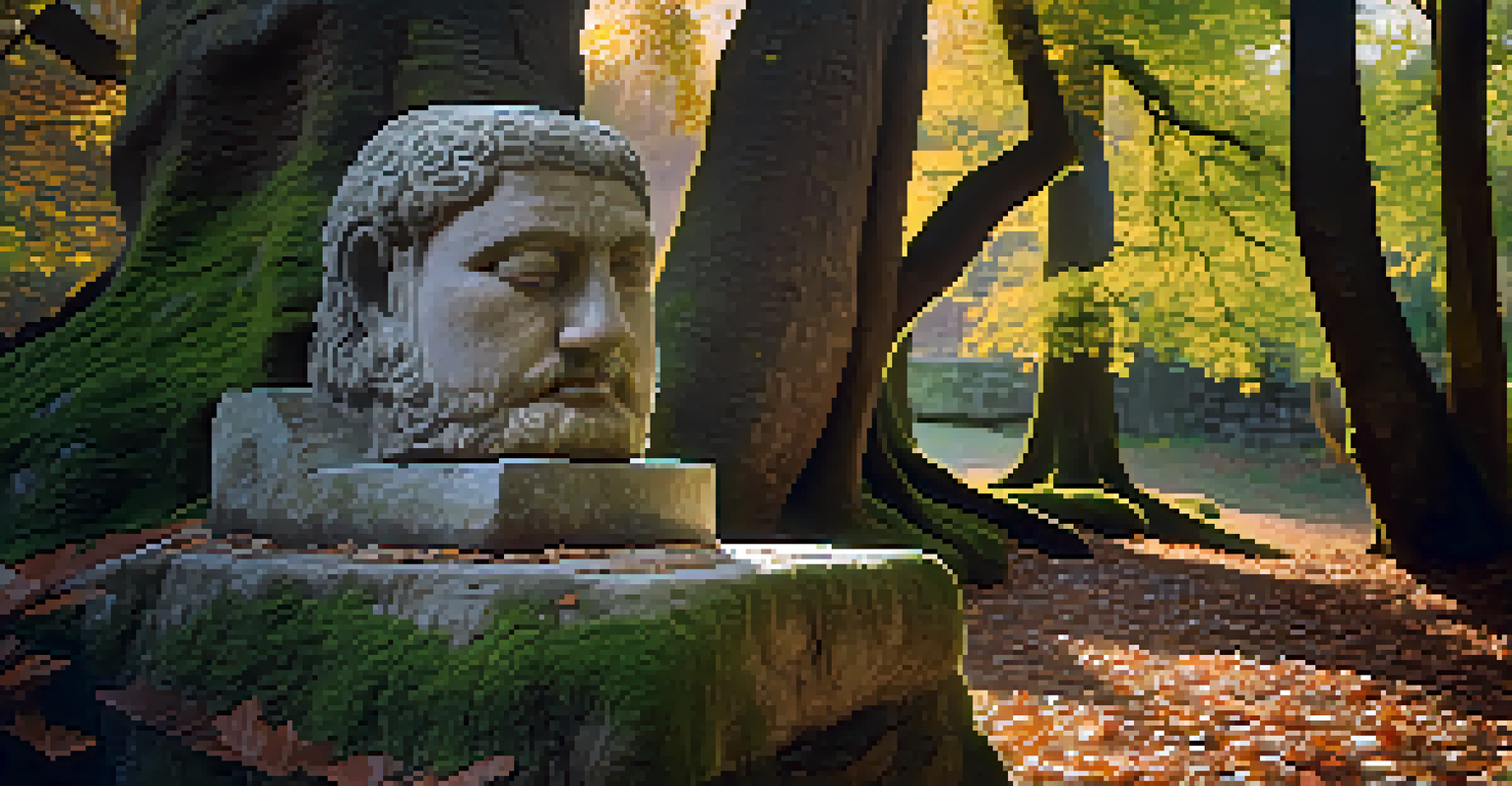The Impact of Environmental Aging on Carved Art

What is Environmental Aging and Its Importance?
Environmental aging refers to the gradual deterioration of materials due to exposure to natural elements like sunlight, moisture, and temperature fluctuations. This process is crucial for understanding how various art forms, especially carved art, maintain their integrity over time. Just like a fine wine, carved art can improve with age, but it can also suffer if not properly cared for.
Art is a reflection of our history, and if it is to endure, we must care for it wisely and diligently.
For example, a wooden sculpture might develop cracks or discoloration when exposed to excessive humidity or sunlight. The changes in texture and color can affect the aesthetic appeal of the piece, potentially diminishing its value. This illustrates the need for art conservators to monitor and manage the environmental conditions where these artworks are displayed.
In essence, recognizing the impact of environmental aging helps artists, collectors, and conservators preserve the beauty and significance of carved art for future generations. It's a reminder that art is not just static; it evolves and requires our attention over time.
Factors Contributing to Environmental Aging
Several factors contribute to the environmental aging of carved art, including temperature, humidity, and light exposure. Each of these elements plays a distinct role in the degradation process. For instance, high humidity can encourage mold growth, while extreme temperatures can cause materials to expand or contract, leading to structural damage.

Light exposure, particularly ultraviolet (UV) light, is another significant factor. UV rays can cause fading and discoloration, particularly in materials like wood and stone. An analogy here could be how prolonged exposure to the sun can lead to sunburn on our skin—carved art can suffer a similar fate if not protected.
Environmental Aging Defined
Environmental aging is the gradual deterioration of materials like carved art due to factors such as sunlight and moisture.
Understanding these factors allows artists and conservators to implement protective measures, such as controlling the display environment or using UV-filtering glass. Such proactive approaches can significantly extend the life and vibrancy of carved artworks.
Materials Used in Carved Art and Their Vulnerabilities
Carved art can be created from various materials, including wood, stone, and ivory, each with unique vulnerabilities. For example, wood is susceptible to moisture, which can lead to warping, while stone may face erosion from acidic pollutants in the air. This diversity means that different types of carved art require individualized care and attention.
Preservation is not only about protection; it’s about understanding the stories that art tells and ensuring they are passed on.
Take wooden sculptures, for instance. If they are not treated or sealed properly, they may absorb moisture from the surrounding environment, leading to splitting or fungal growth. Conversely, stone carvings might be more durable but can still suffer from the effects of acid rain, which can slowly wear down their surfaces.
Recognizing the specific vulnerabilities of each material is essential for effective preservation. This knowledge empowers artists and conservators to choose the right materials and protective measures, ensuring that each piece can withstand the test of time.
Signs of Environmental Aging in Carved Art
There are several signs of environmental aging that can signal the need for intervention. These may include discoloration, cracks, fading, or the presence of mold. Each of these indicators reflects the underlying processes of deterioration that have occurred due to environmental factors.
For example, a carved wooden figure might start to show dark patches or a loss of luster, indicating that it has been subjected to high humidity or inadequate light conditions. Similarly, stone carvings may exhibit signs of wear, like rough patches or pitting, signaling the effects of pollution or weather exposure.
Factors Affecting Carved Art
Temperature, humidity, and light exposure significantly contribute to the aging and degradation of carved artworks.
Being able to identify these signs early on is crucial for anyone involved in the care of carved art. It allows for timely interventions that can halt or reverse the damage, preserving the artwork for future enjoyment and appreciation.
Conservation Techniques for Carved Art
Conservation techniques play a vital role in combating the effects of environmental aging on carved art. These methods can range from simple cleaning to complex restoration processes, depending on the extent of the damage. For instance, a thorough cleaning can remove dirt and grime that may be exacerbating deterioration, while more intricate repairs might involve filling in cracks or re-stabilizing weakened areas.
One effective technique is the application of protective coatings, which can shield wooden sculptures from moisture and pests. For example, using a high-quality varnish can create a barrier that prevents water infiltration while still allowing the wood to breathe. This is similar to how sunscreen protects our skin from harmful UV rays.
Ultimately, the choice of conservation technique should be carefully tailored to each piece, considering its material, condition, and historical significance. This personalized approach ensures that carved art can be preserved in a way that respects both its integrity and its story.
The Role of Environmental Monitoring in Preservation
Environmental monitoring is a crucial aspect of preserving carved art. By keeping track of factors like temperature, humidity, and light levels, conservators can create a stable environment that minimizes the risk of deterioration. This proactive approach is akin to regular check-ups for our health—it's much easier to maintain wellness than to recover from illness.
For example, using hygrometers and thermometers can help maintain optimal conditions for wood carvings, ensuring they are not exposed to extremes that could lead to damage. Additionally, light meters can be utilized to monitor UV exposure, allowing for adjustments to display conditions as needed.
Conservation Techniques Essential
Effective conservation techniques, including protective coatings and environmental monitoring, are crucial for preserving carved art.
Through consistent monitoring, conservators can make informed decisions about when to intervene, whether that means adjusting environmental controls or implementing additional protective measures. This vigilance not only prolongs the life of carved art but also enhances the overall viewing experience.
Future Considerations for Carved Art Conservation
As our understanding of environmental aging evolves, so too does the approach to carved art conservation. Future considerations may include the adoption of advanced materials and technologies that better protect artworks from environmental factors. For example, innovative coatings and treatments could offer enhanced durability against moisture and UV light.
Additionally, the growing awareness of climate change and its impact on humidity and temperature patterns is reshaping conservation strategies. Conservators may need to adapt to these changes by implementing more dynamic monitoring systems or even relocating artworks to ensure their protection.

Ultimately, embracing a forward-thinking mindset will be essential for preserving carved art in an ever-changing world. By staying informed about new developments and being willing to adapt, we can ensure that these treasured pieces continue to inspire and captivate future generations.